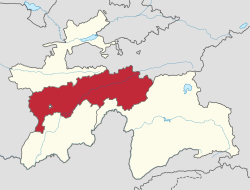Gharm | |
|---|---|
| Coordinates: 39°01′N70°23′E / 39.017°N 70.383°E | |
| Country | |
| Region | Districts of Republican Subordination |
| District | Rasht District |
| Elevation | 1,355 m (4,446 ft) |
| Population (2020) | |
• Total | 9,800 |
| Time zone | UTC+5 |
Gharm [a] is a city and jamoat in the Rasht Valley area of central Tajikistan. The population of the town is 9,800 (January 2020 estimate). [1]
Contents
From the 1920s until 1955, there was a Gharm Oblast in Tajikistan, which included the territory of the current Gharm Valley. Gharm is also the former name of the Rasht District in central Tajikistan.


